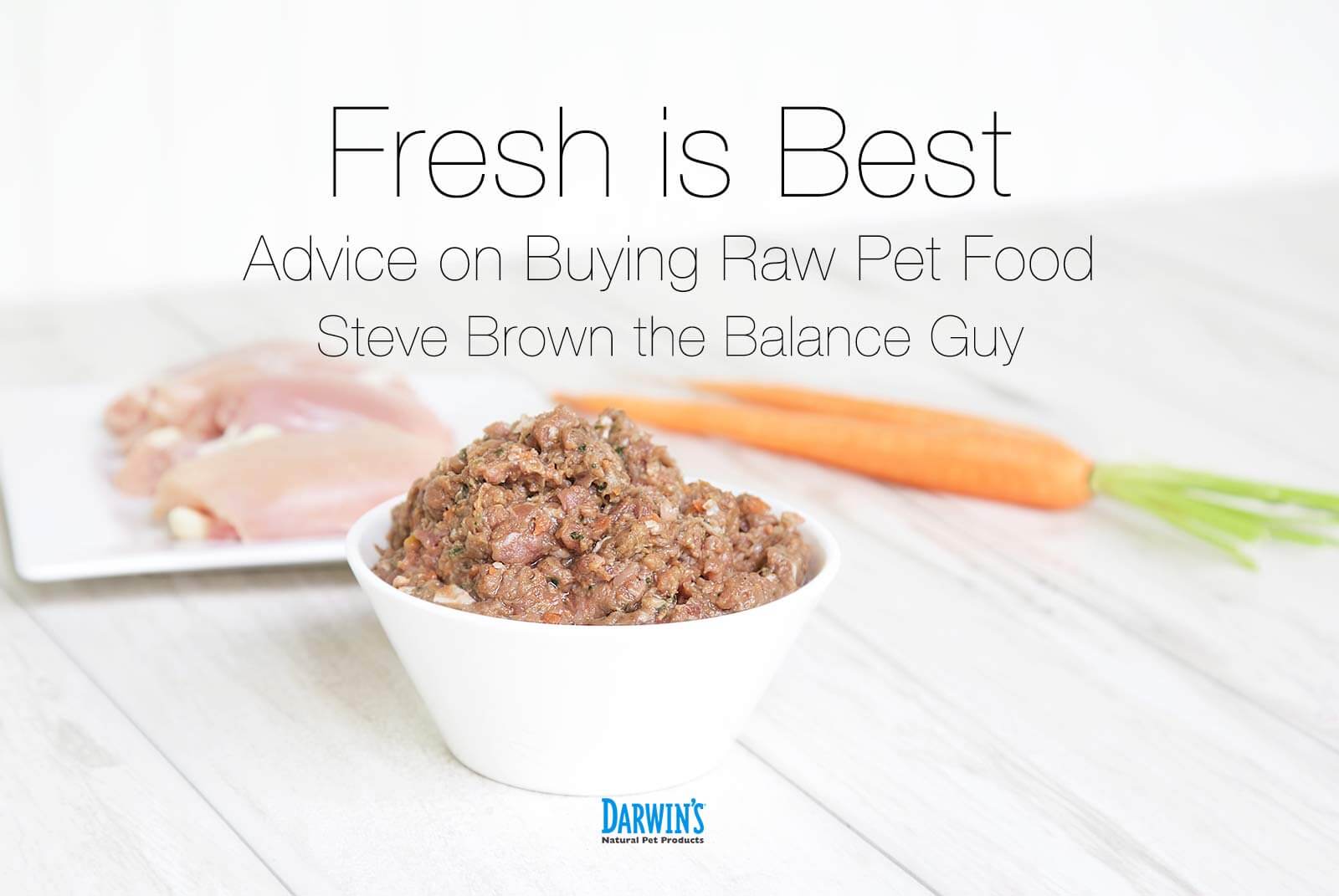Buying Raw Pet Food
4/14/16

Advice On Buying Raw Dog and Cat Food

Fresh is Best –
It’s a basic law of the universe that everything degrades over time. This applies to raw dog and cat food too. As soon as dog or cat food is produced, even if kept frozen, it begins to undergo a variety of chemical and physical changes. These changes include the proteins and vitamins in dog and cat foods, but it’s the fats I worry about the most.1
Dogs require fats in their diet –
However, fats are among the most chemically fragile nutrients in dog food; they are the limiting factor to shelf life to most dog foods. Fats that have degraded – gone “rancid” — can cause all sorts of health problems for dogs. So, how can owners make sure their dogs are getting the healthy fats they need in their diets, without exposing them to rancid fats?
It’s easy: buy recently-produced, well-handled raw foods; look for the “Produced on” date, and visually inspect the food.
For raw foods, expiration dates are meaningless –
Look at the date on the bag of food and, if it’s a “Best if used by” date, ask the manufacturer or retailer how many months before that date the food was produced. If they can’t or won’t tell you, don’t buy the food. The pet food distribution system – going through distributors and retailers – is designed for dry and canned foods to have one to two-year shelf lives at warehouse temperatures. Fresh frozen foods have a short shelf life and special handling requirements. This may force some manufacturers to give their foods unreasonably long “Best if used by dates” just so they can work with distributors and retailers.
The shelf life for “quality” raw diets: 3 to 4 months –
Even when frozen, nutrients degrade over time, and ground meats degrade faster than whole meats.
Most commercial raw diets are made from ground raw meat. According to the USDA, ground meats, to be considered “quality,” have only a 3 to 4-month shelf life. Here is a portion of the USDA frozen storage chart, from their fact sheet, Focus on Freezing. This chart estimates the shelf life for quality, in months, for frozen meats, kept at a steady 0°F2.
|
Months |
|
4 to 12 |
|
4 to 12 |
|
3 to 4 |
|
12 |
|
9 |
|
3 to 4 |
When raw meat freezes, the water within the meat forms ice crystals; the ice crystals grow even at a steady 0°F. The longer the time in the freezer, the larger the ice crystals become, and the more likely that they will puncture cell walls, and perhaps break some of the double bonds in the unsaturated fats.
Grinding meats significantly shortens shelf lives because the grinding breaks the protective cell walls of the meat and fat cells, making the fragile nutrients more exposed to oxidizing agents.
Buying raw pet food –
One of the reasons I recommend and feed Darwin’s Pet Foods is that it’s the freshest raw dog and cat food one can buy. The Produced-on-date is stamped on every package. Darwin’s produces the foods and then ships the food directly to the consumer. The food is usually less than 3 months old when fed, and there are no distributors and retailers who can mishandle the food, which reduces nutrition and perhaps creates rancid fats.
Raw foods sold in retail stores can be excellent, however, some may not be worth your money or may contain rancid fats. The difference is almost always the quality of the retailer. Try to buy your foods from retailers that are meticulous in their handling and rotating of raw foods. Foods are kept best in freezers that are not frost-free, because frost-free freezers cycle the temperatures up and down in order to reduce the frost build-up in the freezer, making nicer looking freezers, but poorer quality food. Good retailers order raw foods often (they do not overstock raw foods), rotate their stock consistently, have quality freezers that keep the food at constant temperatures, know the manufacturers, demand the best from them, and often test their products.
Just like buying meat at the store, always inspect the food –
If the food is formed into nuggets or patties, and they are sticking together, it’s a sign that the food underwent temperature cycling, and the food should probably be avoided. The food should look and smell fresh. If the food is gray or off-color, it may be old.
When I had my own company, I found that almost all the problems we had with the foods were because the food was mishandled in distribution or by the retailer. I remember two pallets of food that were kept on a distributor’s dock for almost 8 hours. The temperature probes we placed in the foods showed that the food near the outside of the pallet had defrosted, and then refrozen when the distributor finally placed the food in the freezer. The food was no longer quality and had to be replaced. The distributor’s main business was dry and canned foods and did not understand the specific requirements of frozen raw goods.
The bottom line: Buy Fresh! To get the best dog and cat foods possible, buy recently produced foods that were handled well.
Interested in Steve’s previous chapters?
– Bringing Out the full Health Potential of Your Dog – Focus on Nutrients Part 1
– Steve Brown’s Introduction to Focus On Nutrients Part 1
[1] For more information, see my Whole Dog Journal article, December 2012 Fats’ Chance: The problems with dietary fat in commercial dog food, and how you can fix them for a smarter and healthier dog.
[2] http://www.fsis.usda.gov/Fact_Sheets/Focus_On_Freezing/index.asp#12
 Steve Brown is a dog food formulator, researcher, and author on canine nutrition. In the 1990s he developed one of the leading low-calorie training treats, Charlee Bear® Dog Treats, as well as the first AAFCO-compliant raw dog food. Since 2003 he has focused on research and education. He is the author of two books on canine nutrition (See Spot Live Longer, now in its 8th printing, and Unlocking the Canine Ancestral Diet (Dogwise Publishing, 2010); and a 40-page booklet, See Spot Live Longer the ABC Way.
Steve Brown is a dog food formulator, researcher, and author on canine nutrition. In the 1990s he developed one of the leading low-calorie training treats, Charlee Bear® Dog Treats, as well as the first AAFCO-compliant raw dog food. Since 2003 he has focused on research and education. He is the author of two books on canine nutrition (See Spot Live Longer, now in its 8th printing, and Unlocking the Canine Ancestral Diet (Dogwise Publishing, 2010); and a 40-page booklet, See Spot Live Longer the ABC Way.



